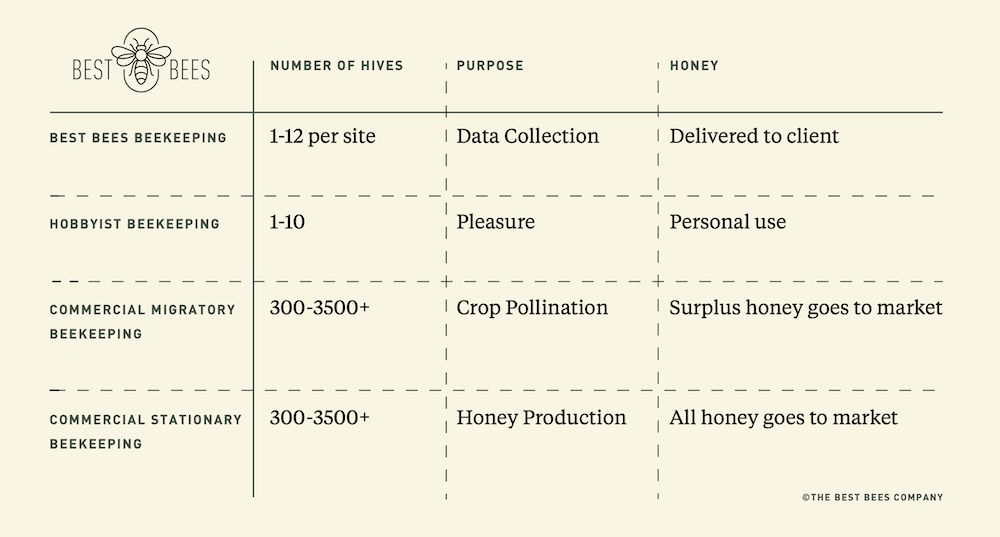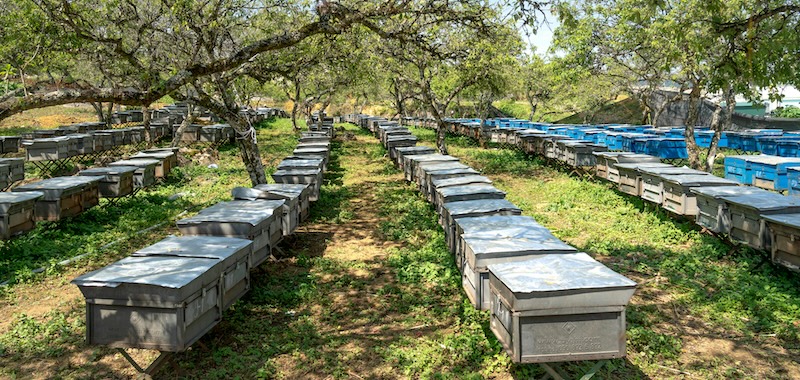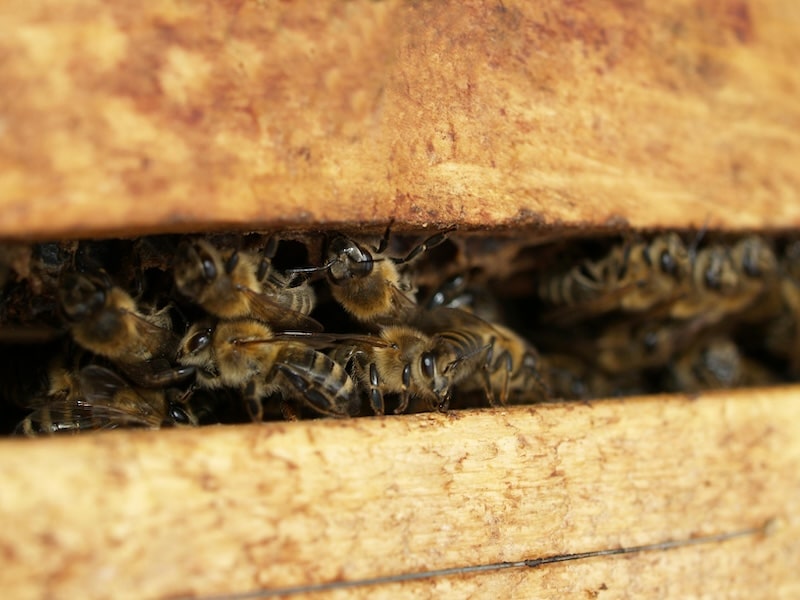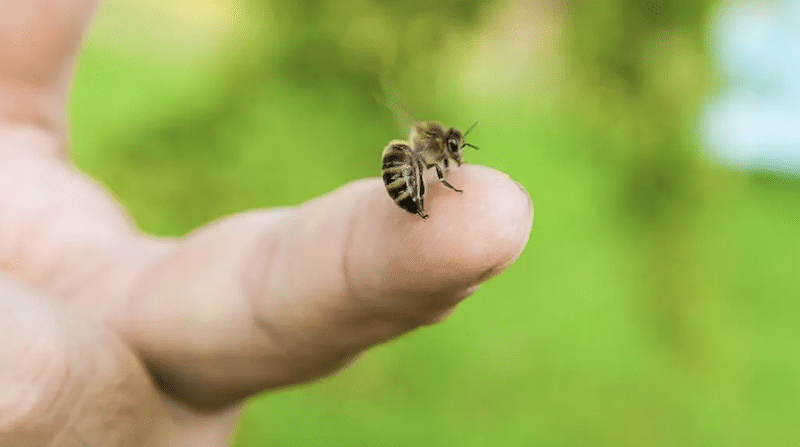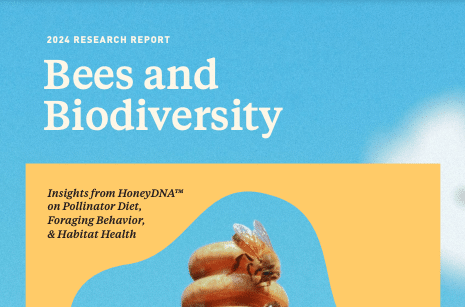Content:
- What is Commercial Beekeeping/Migratory Beekeeping?
- What is Non-Commercial Beekeeping?
- History of Commercial Beekeeping in the US
- Current State of Commercial Beekeeping
- The Economic Value of Commercial Beekeeping
- Commercial Beekeeping Impact on Bee Health
- Commercial Beekeeping Environmental Impact
- The Distinctions Between Best Bees Beekeeping, Hobbyist Beekeeping, and Commercial Beekeeping
- FAQs
What is Commercial Beekeeping/Migratory Beekeeping?
Commercial beekeeping is the management of hundreds to thousands of beehives for pollination services and/or honey production. Whatever the purpose, a commercial beekeeping operation runs like a business, with the bees as the employees generating profit; a key characteristic of commercial beekeeping is that the venture is the owner’s primary source of income.
There are two types of commercial beekeeping operations: migratory and stationary. Stationary commercial beekeeping operations are typically focused on honey production. Around 125 million pounds of honey are produced annually in the United States, with recent wholesale prices around $2.98 per pound nationally. With honey as delicious as it is and having so many beneficial properties, it’s no wonder that the US honey market is expected to be worth over $5 billion by 2030.
Migratory commercial beekeeping makes up the bulk of commercial beekeeping; it is the practice of moving honey bees to meet the pollination demand from farmers. The business model has developed such that commercial beekeepers and honey bees embark on a seasonal migration together. They start their journey in California to pollinate the almond harvest, then head to Montana for alfalfa pollination. Next, they go to Washington and Oregon for pears and cherries; across the plains to Wisconsin and the Dakotas for cranberries; then onto Ohio, Indiana, Illinois, and Pennsylvania for apples, peaches, and cherries; and finally to the Northeast for blueberries and cranberries.
They also travel to follow the forage; many migratory commercial beekeeping operations are dual-purpose and provide honey production as well as pollination services. The timing of when the bees hit the Great Plains and the Dakotas coincides with peak nectar flow, and the area has a large amount of conservation reserves. In fact, North Dakota is the top honey-producing state in the US.
This type of commercial beekeeping generates profits from contracts with farmers and crop growers across the country. Over the past decade, the pollination services market has grown, and in 2018, the USDA Economic Research Service reported that pollination services now exceed honey as a source of beekeeper income. For comparison, as late as 1988, pollination services accounted for only 11 percent of beekeeper revenue.
What is Non-Commercial Beekeeping?
Non-commercial beekeeping involves much fewer beehives than commercial beekeeping, and does not include migration. Beekeepers for whom beekeeping is their side hustle, hobbyist beekeepers, and beekeeping for research purposes constitute non-commercial beekeeping.
Urban Beekeeping
Urban beekeeping is the practice of managing and caring for beehives within urban environments, such as on rooftops, balconies, urban corporate campuses, community gardens, and public parks.
Backyard Beekeeping
Backyard beekeeping is typically conducted in suburban environments, where residencies have individual properties with yards or gardens. Beehives are kept in gardens, side yards, and backyards.
History of Commercial Beekeeping
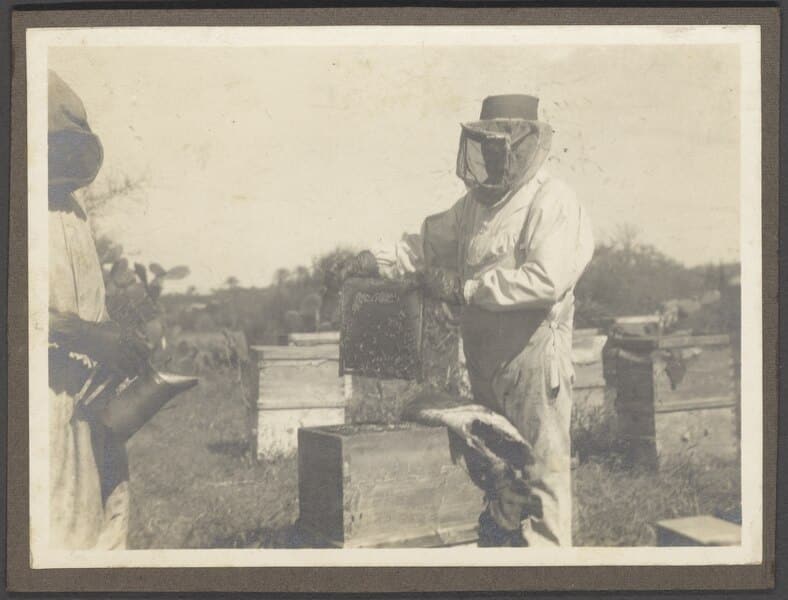
The earliest information available indicates that colonies of honey bees were shipped from England and landed in the Colony of Virginia in 1622. The years following, more shipments were made to other colonies, including Massachusetts, New York, Pennsylvania, Carolina, and Georgia.
These early hives were likely kept in wooden boxes, pottery vessels, and straw skep beehives; honeycomb built in such hives could not be removed and manipulated like the hives of today. In 1852, Rev. Lorenzo Langstroth, an amateur beekeeper in Pennsylvania, patented a hive with moveable frames that is still used today.
Langstroth realized that the bees would build comb in a space wider than three-eighths of an inch, and they would fill a space smaller than that with propolis and wax. By spacing frames about three-eighths of an inch apart, he created a hive that would allow beekeepers to inspect and remove frames (including honey frames for harvest) without harming the colony’s functions.
This invention revolutionized beekeeping and galvanized other inventions that made large-scale commercial beekeeping possible. According to Everett Oertel in his History of Beekeeping in the United States, wax-comb foundation, invented in 1857, made possible the consistent production of straight, high-quality combs of predominantly worker cells. This encouraged the development of colonies with greater populations of foraging bees, which made them more productive at pollinating crops. On the honey side of things, the centrifugal honey extractor was invented in 1865 and made large-scale production of extracted honey possible.
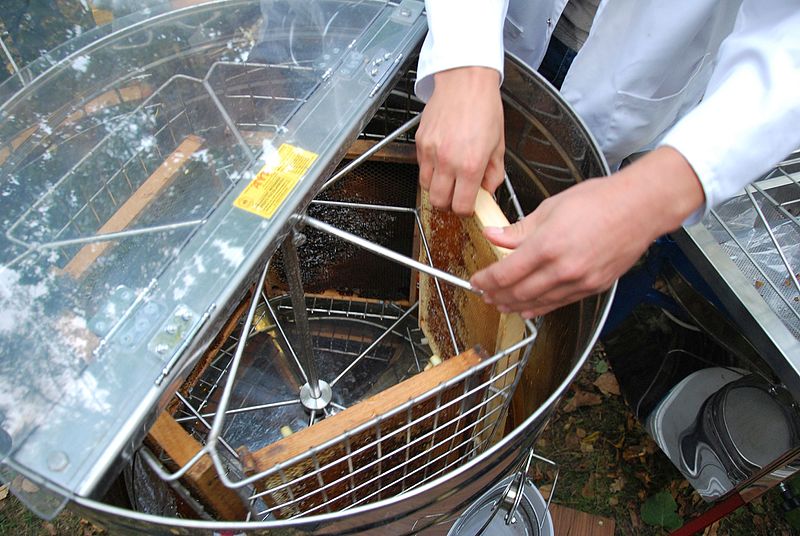
Poor roads and use of horse-drawn carriages restricted the size of the area in which a beekeeper could operate, but after WW1, better highways and motor vehicles allowed commercial beekeepers throughout the US to expand the size of their businesses. Transportation innovations (internal combustion engines, trucks, and better roads) made migratory beekeeping possible. At first, migratory beekeeping was adopted to comb the American landscape for nectar sources, since demand for honey had skyrocketed due to the sugar shortage during WW1.
Developments in beekeeping occurred roughly around the same time that the tractor began to revolutionize the cultivation of crops. As agricultural production increased thanks to technological advancements — and population growth resulted in increasing demand for agricultural production — farmers started to realize the connection between improved crop yields and the presence of migratory, honey-producing beekeeping ventures.
According to the USDA, the first recorded renting of colonies for the purpose of pollination services was in 1910. As time went on, knowledge about bee pollination and its benefits for crop production grew more commonplace; this was critical to the emergence of a pollination services market. Beekeepers began entering contracts with farmers to improve the yields of melons, orchard crops, and later alfalfa and vegetables.
Still, as late as 1988, pollination services accounted for only around 11 percent of beekeeper revenue. In 2016, that share had risen to 41 percent, slightly surpassing revenue from honey sales — the remainder being sales of beeswax, package bees, and queen bees.
The expansion of the pollination service market can be attributed primarily to the growth in acreage for almonds. Compared with other crops, almonds require more honey bees per acre for pollination and suffer greater yield losses without them. Nearly all US almond acreage is in California; as the crop’s demand for pollination services outstripped local supply, migratory commercial beekeeping ventures became in even greater demand.
Across the board, demand for commercial beekeeping pollination services rose as natural pollination’s availability and quality decreased. This is due to pests such as the varroa mite decimating wild honey bee colonies, and habitat degradation .
Current State of Commercial Beekeeping
America’s honey bee population is at an all-time high; the Census of Agriculture reports that we have 3.8 million bee colonies. However, the Bee Informed Partnership’s annual colony loss survey for the 2022-2023 beekeeping season reports a 48.2% loss rate — almost half of all colonies died.
It’s not that the honey bees aren’t struggling; it’s that they are too important agriculturally and economically to let them decline. As mentioned earlier, almonds are a huge reason why the pollination market is expanding and the number of colonies is increasing. In 2022, the US almond crop was 2.5 billion pounds, valued at $3.5 billion, coming from 1.6 million acres. For this year, the USDA estimates that the almond crop will come in at three billion pounds; notably, the National Agricultural Statistics Service (NASS) reported that bee hours were significantly higher in 2024 than in 2024.
The declining availability of suitable forage land for honey bees has led to the cost of beekeeping increasing — the bees need supplemental pollen and nectar to make up for the lack of forage caused by habitat loss. Additionally, more mite treatments are needed to keep varroa under control, and more queen bees need replacing as the viruses spread by varroa shorten their lifespan. All of this has caused labor costs to increase as well. These rising costs of running a commercial beekeeping venture are partially passed on to pollination-dependent crop producers, as the service fees for pollination services increase to account for the rising cost of beekeeping.
The Economic Value of Commercial Beekeeping
Pollinators as a whole contribute up to $577 billion annually in global food production; honey bees in the US alone contribute nearly $20 billion. If you factor in the medicines, biofuels, fibers, raw materials, and products bees and other pollinators provide, globally, pollination services are likely worth more than three trillion dollars.
Aside from food production, honey bees contribute to the economy through the commodification of honey, beeswax, propolis, and royal jelly. The global honey market value is expected to reach $13.6 billion by 2030, according to Grand View Research. In 2017, the US honey industry was responsible for more than 22,000 jobs.
Agriculture is steadily increasing its dependency on pollination services; the actual volume of agricultural production that relies on animal pollination has increased by 300% over the last 50 years. The honey bee pollination services are worth between $250 million and $320 million annually, according to the USDA’s Economic Research Service, and that value will only continue to grow as demand increases.
Commercial Beekeeping Impact on Bee Health
Impact on Honey Bee Health
Research from North Carolina State University shows that migratory bees generally have shorter lives than stationary bees. Traveling bees also have greater oxidative stress levels – which ages them more quickly and may lessen their capacity to fight off disease and parasites.
In industrial agriculture, monocrop landscapes provide limited nesting habitat and forage resources, and pollinators are exposed to an abundance of agrochemicals. Honey bees need a diverse diet to meet their nutritional needs, yet on their migration journey has them foraging on one individual crop for weeks at a time before moving onto the next one. Monoculture farming can provide honey bees with a lot of forage all at once, but the resources they offer are short-lived and lacking in that much-needed diversity and nutritional quality.
Since the goal of industrial agriculture is to maximize crop yield while minimizing labor costs, they use synthetic fertilizers and pesticides to expedite crop production. Herbicides kill the so-called weeds that would otherwise provide important forage resources. Fungicides disrupt honey bees’ gut biomes and metabolisms. Insecticides reduce cognitive functioning, like the bees’ abilities to learn, communicate, and navigate, and harm their reproductive process.
Since bees are rarely ever exposed to just one type of pesticide, there are synergistic effects when honey bees are exposed to multiple chemicals in occurrence with each other. Pesticides, insecticides, herbicides, etc all have individual toxicity levels, and when honey bees are exposed to more than one at the same time, the overall toxicity level is increased. Bees are often exposed to “chemical cocktails” – a result of mixing pesticides in tanks before being sprayed on crops.
Additionally, high population density facilitates the spread of parasites and pathogens. Commercial beekeeping operations maintain hundreds to thousands of honey bee colonies in a condensed area; this makes it easy for Varroa mites to spread from hive to hive.
Impact on Wild Pollinator Health

Small-scale, non-industrial, diversified farming systems leverage the natural ecosystem services of a healthy, biodiverse environment to support sustainable food production. These include processes like pollination, pest control via natural predation, soil formation, and water regulation.
Industrial agriculture disrupts and degrades the natural environment, limiting nesting habitat and forage resources and exposing pollinators to chemicals. As a result, the overall abundance and diversity of wild pollinators decreases, leading to commercial beekeepers bringing in honey bees to provide the pollination services.
This increases the competition between wild pollinators and honey bees for resources, and since honey bees are generalist pollinators that work together as a team to forage for their colony, they will outcompete the solitary wild pollinators that tend to be specialist pollinators.
Additionally, as the stress migratory beekeeping puts on honey bees makes them increasingly vulnerable to pests and pathogens, the transmission of pests and pathogens between managed honey bees and wild pollinators (and vise versa) increases.
The scientific literature investigating the effects of managed honey bees on wild pollinators has expanded considerably in recent years, but lacks measurement of the direct effects — instead, studies have documented the potential for impact. More research is needed before we fully understand the true effect on commercial beekeeping on wild pollinators.
Commercial Beekeeping Environmental Impact
The environmental impact of commercial beekeeping varies depending on the type of venture and the weather conditions of a given season.
Migratory beekeeping has greater greenhouse gas emissions than stationary commercial beekeeping due to the transportation (and subsequent fuel and energy consumption) necessary to cart honey bees across the country to meet pollination demand.
During seasons with scarce rainfall, commercial beekeepers need to increase the amount of supplemental feeding they provide their bees. Pollen patties, which replace natural pollen sources, consist of a dry base protein derived from soy, wheat, egg, yeast, or lentils. These patties, while effective, require water and crops to produce, and the processing to create the final product emits greenhouse gasses and requires greater energy expenditure.
The Distinctions Between Best Bees Beekeeping, Hobbyist Beekeeping, and Commercial Beekeeping
FAQs
Q: What is commercial beekeeping?
A: Commercial beekeeping is the management of hundreds to thousands of beehives for pollination services and/or honey production.
Q: What is non-commercial beekeeping?
A: Non-commercial beekeeping involves much fewer beehives than commercial beekeeping, and does not include migration. Beekeepers for whom beekeeping is their side hustle, hobbyist beekeepers, and beekeeping for research purposes constitute non-commercial beekeeping.
Q: What led to the rise of commercial beekeeping?
A: First, advancements in beekeeping practices, particularly the invention of the Langstroth hive, and second, advancements in transportation (internal combustion engines, trucks, and better roads) and the mechanization of agriculture.


